Marine Corps Air Station Miramar, CA–Marines and Sailors with 3rd Marine Aircraft Wing (MAW) prepare for an island-hopping campaign as part of advanced naval base training during Exercise Winter Fury 22.
With units positioned across California, Arizona, and Washington, both on land and at sea, 3rd MAW tested components of expeditionary advanced base operations in preparation for future maritime conflicts in the Indo-Pacific region.
Expanding upon the island hopping blueprint developed in the Pacific Theater of World War II, 3rd MAW synchronized the seizure of strategic airfields on Camp Pendleton, San Clemente Island, Laguna Army Airfield, and Moses Lake, Washington which enabled the Marine Aircraft Groups (MAG) to support follow-on actions throughout a vast area of operations.
During the course of the evolution, Marines with MAG-11 and MAG-13 reinforced 3rd MAW efforts by establishing a joint forward arming and refueling point (JFARP) at Grant County International Airport in Moses Lake, Washington. This enabled both F-35B and F/A-18C aircraft to rapidly conduct long-range strike operations stretching from Arizona to Washington State.
Concurrently, Marines with MAG-39 established advanced naval bases (ANB) on Camp Pendleton, Fort Hunter Liggett, and San Clemente Island, allowing AH-1Z, UH-1Y, and MV-22B aircraft to push the fight further into a contested maritime theater. These ANBs effectively increased the range and tempo of aviation operations within the simulated island chain, increasing 3rd MAW’s ability to help control a maritime region.
Additionally, MAG-39 conducted operations with MH-60Rs from Helicopter Maritime Weapons School Pacific to assist in the Navy’s anti-submarine warfare mission. This marked the first time that a Marine Corps MV-22B deployed a screen of SSQ-53G sonobuoys, less than a year after the first Marine Corps UH-1Y conducted the same operations. The MV-22B’s speed and range can be leveraged to augment the Navy sub-hunting helicopters by deploying the tracking buoys while the MH-60Rs are off station to refuel.
Another unique event for MAG-39 was the deployment of the Joint Precision Aerial Delivery System of fuel bladders via MV-22B aircraft. This enabled UH-1Y aircraft to land at predetermined coordinates, refuel and rearm, and get back in the fight without having to return to a FARP.
At Laguna Army Airfield, Marines from MAG-16 provided assault support for 3rd MAW operations during Winter Fury. While at Laguna Army Airfield, MAG-16 MV-22B and CH-53E aircraft recovered a retired UH-1 Iroquois rotary aircraft as part of a Tactical Recovery of Aircraft and Personnel mission.
MAG-16 also took part in a large-scale air assault mission with a reinforced infantry company from 1st Battalion, 4th Marines.
As warfighting proves to be ever-changing, 3rd MAW continues to implement concepts from Force Design 2030 through adversarial-minded wargaming and combat-driven exercises. During Winter Fury 22, 3rd MAW units participated in evolutions such as advanced naval base training, long-range strike operations, and anti-submarine warfare, enhancing readiness and lethality in support of a maritime campaign.
3rd MAW continues to “Fix, Fly and Fight” as the Marine Corps’ largest aircraft wing, and remains combat-ready, deployable on short notice, and lethal when called into action.



